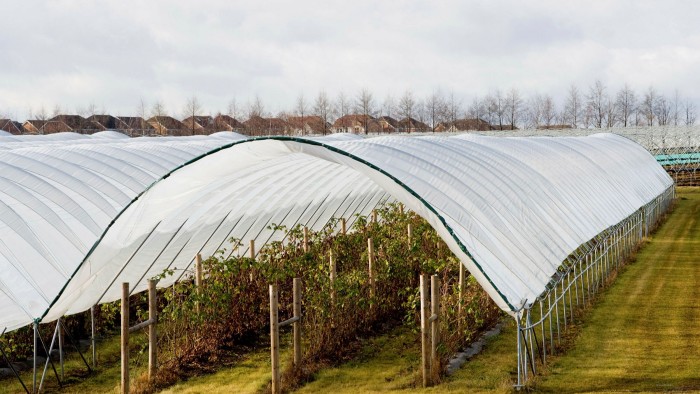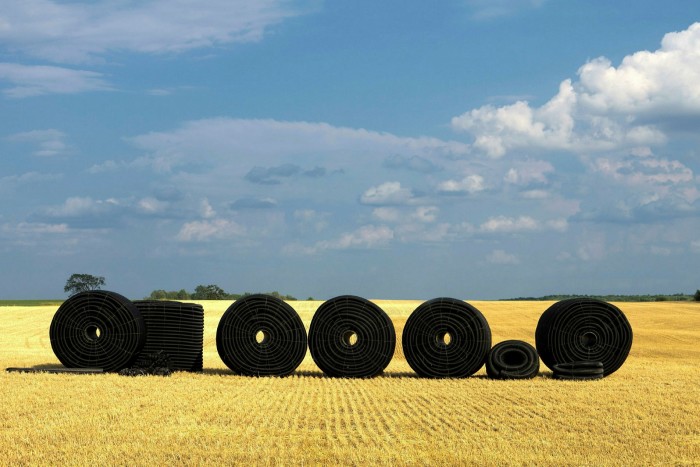How to deal with farmers’ love of plastic

Roula Khalaf, Editor of the FT, selects her favourite stories in this weekly newsletter.
Polytunnels divide opinion. For some, these long, plastic-sheeted structures that are used to grow crops blight the landscape. Others say they enable more produce to grow locally. Now, they are the focus of another debate: how to stop polluting agricultural plastic going to landfill or for incineration.
The 12.5mn tonnes of plastic used in agriculture every year (from crops and livestock to aquaculture and forestry) is only 3.5 per cent of the total produced globally, according to the UN Food and Agriculture Organization. But volumes are growing rapidly.
Barry Friesen cannot remember plastic being used on the dairy farm where he worked as a teenager in the 1970s. Today, as executive director of Cleanfarms, a Canadian non-profit that helps farmers recycle, he says: “The hay is wrapped in plastic, the twine is plastic. In one generation, we’ve gone from very little plastic use to a lot of plastic use — and that’s just one industry.”
Agricultural plastic is not usually recycled. In the UK, only 30 per cent of non-packaging agri-plastics, such as polytunnels and bale wrap — excluding packaging such as chemical containers and sacks — is collected for reuse, according to APE (Agriculture Plastics Environment) UK.
APE UK, part of APE Europe, a plastics industry-led initiative, aims to push this to more than 70 per cent within five years, by cutting the cost to farmers.
However, what the Food and Agriculture Organization recently described as farming’s “disastrous use of plastics” receives less public attention than the consumer equivalent, and less than other sources of harm to the environment. “The big news items are errors with silage or a waste water management system flowing into rivers,” says Ian Creasey, chief executive of APE UK. “That gets more attention because it’s had a direct impact.”
The trouble is that agricultural plastic helps grow more food in a hungry world, says Creasey. Yields in polytunnels are higher than those for produce grown in the open. The soil retains more moisture and weeds grow less well, which cuts the need for pesticides. Sheets of plastic bale wrap are also often essential for storing feed in winter.
“Plastics play a really important part in farm life and have environmental benefits,” says Creasey. “That works if you efficiently collect the plastic on the farm. It doesn’t work if there isn’t that ‘circularity’ and you let that plastic get burnt or go to landfill.”
One UK initiative trying to break the model of making and discarding agri-plastics is the Green Tractor Scheme. By collecting and processing the plastic, it aims to enable farmers to have all their packaging recycled before 2030.
Since 2010, via 1,600 collection sites in Canada, Cleanfarms has recovered more than 45,700 tonnes of plastic containers, and 1,400 tonnes of grain bags, film and twine. Contractors take this to centralised locations, shred it and turn it into new plastic, says Friesen.

Among those now pressing farmers to recycle more plastic are big food retailers and the assurance schemes that show produce has met environmental, safety and other standards. “They’ve got their buyers pushing them,” says Mark Webb, farm recycling collection service Farm XS co-owner, who leads the Green Tractor Scheme. “Farm assurance schemes want evidence of legitimate disposal, preferably for recycle and reuse.”
Some countries are starting to ban farm plastics from being burnt. And in the UK, from April, under the plastic packaging tax, importers or producers will pay a tax on products that contain less than 30 per cent recycled material.
More stories from this report
Leftovers form key ingredient in food sector climate plans
‘Right to repair’ campaign is forcing a rethink by Big Tech
Olympic legacy of Japan’s experiment in urban mining
Carmakers . . . before cars makes their first journey
Can kelp help? Investors eye sustainable harvest from seaweed
Young shoppers give a new twist to fashion
Why modular housing is still small-scale
History’s guide to making reuse an everyday habit
Cement makers focus on waste collection in quest to cut carbon
Plastics recyclers tackle increase in waste from the pandemic
Recycled agri-plastic has plenty of uses. Some reappears on farms as fencing, protection for seedlings and drainage tiles. Other sectors such as construction use it for sheeting or insulation.
Still, collection and recycling it is not easy. Agri-plastic’s many forms mean the collected waste must be sorted and separated as well as cleaned. “Some of [the used plastic] is 50 per cent muck and water,” says Webb.
“For every kilogramme sold to the farm as new plastic, you pick up twice that weight when it’s used,” says Creasey. APE UK last year launched a voluntary scheme in which manufacturers pay a levy — equivalent to £20 per tonne of their new agri-plastic product sales — into a fund that helps cover the “gate fees” recyclers charge for the collected waste they receive at their facilities.
“The collection cost is still there,” says Creasey. “But the recycler will invoice APE for the gate fee . . . so that’s not a cost the farmer has to bear.”
However, he believes recycling will ultimately generate value for farmers. “The fact that the recycling gate fee is starting to go down is because recyclers want more of this plastic,” he says.
Comments